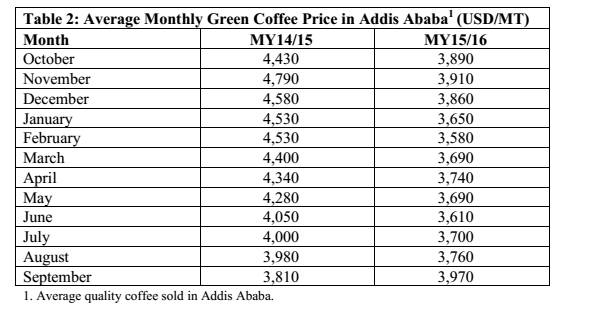Annual report on Ethiopian Coffee 2017
Content summary
Ethiopia's coffee production is expected to remain at 6.545 million bags in 2017 / 18. The export is expected to be 3.31 million bags. In June this year, in order to stimulate exports, the government plans to reform the coffee marketing and trading system, one of the most anticipated is that coffee will no longer have to be exported through the Ethiopian Mercantile Exchange (ECX) (see the next article for details on the trading process and system principles of ECX). The effectiveness of the reform remains to be seen.
Output
Coffee production in 2017 is expected to be slightly higher than the 6.545 million bags in 2016 / 17. The area planted and harvested is almost the same as the previous year. This article slightly revised USDA estimates for 2016 / 17 and 2015 / 16.
Under the second Development and Transformation Plan (GTP II), the Government of Ethiopia hopes to increase coffee production to about 1 million metric tons in 2019 / 20. However, considering the existing production situation, it is impossible to achieve this goal in such a short time. More money and resources are needed to develop varieties, promote support, invest more (chemical fertilizers and irrigation), and improve tree management. If Ethiopia can take advantage of the existing acreage to double its productivity and reach the yield of Brazil, production will rise to 800000 metric tons, which will be closer to the GTP II target.
The newly established Coffee and Tea Development and Marketing Authority (CTDMA) under the Ministry of Agriculture is responsible for formulating development plans to support the goal of increasing coffee production. For example, CTDMA plans to provide greater credit lines and assistance to farmers, and plans to restructure Ethiopia's coffee marketing system to allow growers and traders to sell products directly to foreign buyers to expand exports.
Coffee production in Ethiopia has stagnated over the past five years. Hovering around 6.5 million bags, the planting area has hardly changed. As shown in Table 1. CTDMA hopes to change the past by increasing the production of existing coffee.

Consumption
Consumption is expected to be 3.24 million bags in 2017 / 18, almost unchanged from last year. Owing to strong domestic demand and lower-than-expected exports, the present report has revised up consumption to 3.2 million bags in 2016 / 17. More than half of the output of coffee is consumed in China.
As shown in table II, Ethiopian coffee prices have been on a downward trend since 2014 / 15. The price decline is partly due to the fall in the price of international coffee. Nevertheless, the price of Ethiopian Arabica coffee is higher than the international price, averaging $280 higher than the international price in 2015 / 16. It should also be noted that high-quality coffee is more expensive.

Trade
Exports are expected to stabilize at 3.31 million bags in 2017 / 18. In order to stimulate exports, the government plans to reform the coffee marketing and trading system, the effectiveness of the reform remains to be seen.
USDA estimates that exports fell to 3.3 million bags in 2016 / 17 due to lower-than-expected exports. According to the Ethiopian government, exports from October 16 to March 17 were about 77000 metric tons, compared with 84000 metric tons in the same period last year.
Export data for 2015 / 16 have been updated to 3.4 million bags, with the top five export destinations being Germany, Saudi Arabia, Japan, the United States and Japan.

Inventory
The inventory is expected to be 20,000 bags in 2017 / 18. USDA estimates that inventories will fall to 25000 bags in 2016 / 17.

Policy
Ethiopia relies heavily on foreign exchange inflows to cover government spending and imports in particular foreign exchange inflows from exports of coffee and other agricultural products. Coffee accounts for 1/4 of Ethiopia's export earnings.
The government is proposing several reforms to improve the coffee marketing and trading system. One of the most anticipated is that coffee will no longer have to be exported through the Ethiopian Commodity Exchange (ECX). This reform provides coffee exporters with the opportunity to sell non-GM coffee to foreign buyers, which is impossible under the ECX platform.
Important Notice :
前街咖啡 FrontStreet Coffee has moved to new addredd:
FrontStreet Coffee Address: 315,Donghua East Road,GuangZhou
Tel:020 38364473
- Prev

Vietnam Coffee Annual report 2017
Main points of the report Vietnam coffee production in 2016 / 17 was revised from 26.7 million bags to 26 million bags due to abnormal rainfall during the harvest season, resulting in a smaller than expected yield. The weather conditions were good in the first half of the year, with an estimated production of 28.6 million bags, an increase of 10 per cent over the 17th of 2016. The abundant rainfall from January to March makes the coffee tree send out more branches and bloom.
- Next

How to distinguish the description of color, flavor and taste of deep-roasted Brazilian coffee beans
Follow Cafe (official Wechat account vdailycom) found that the vast majority of Brazilian coffee is sour, sweet, bitter, mild-tempered and versatile. Accompanied by the rich Indonesian Mantenin, there will be a mellow chocolate taste; when matched with fruity and floral African beans, it will highlight special aromas such as fruits and nuts. Work
Related
- Detailed explanation of Jadeite planting Land in Panamanian Jadeite Manor introduction to the grading system of Jadeite competitive bidding, Red bid, Green bid and Rose Summer
- Story of Coffee planting in Brenka region of Costa Rica Stonehenge Manor anaerobic heavy honey treatment of flavor mouth
- What's on the barrel of Blue Mountain Coffee beans?
- Can American coffee also pull flowers? How to use hot American style to pull out a good-looking pattern?
- Can you make a cold extract with coffee beans? What is the right proportion for cold-extracted coffee formula?
- Indonesian PWN Gold Mandrine Coffee Origin Features Flavor How to Chong? Mandolin coffee is American.
- A brief introduction to the flavor characteristics of Brazilian yellow bourbon coffee beans
- What is the effect of different water quality on the flavor of cold-extracted coffee? What kind of water is best for brewing coffee?
- Why do you think of Rose Summer whenever you mention Panamanian coffee?
- Introduction to the characteristics of authentic blue mountain coffee bean producing areas? What is the CIB Coffee Authority in Jamaica?

